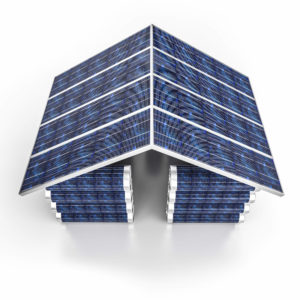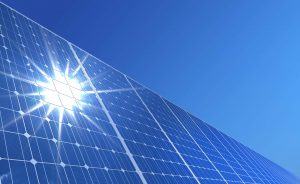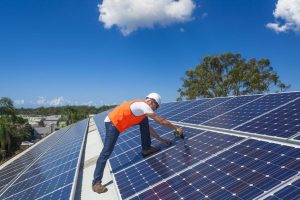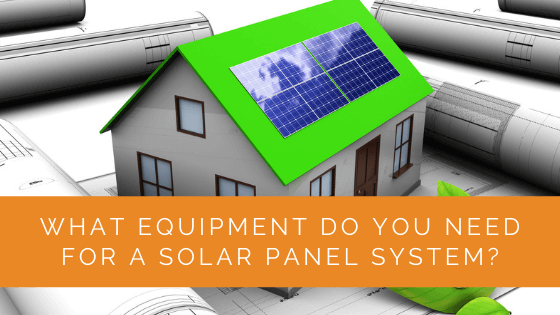When understanding the intricacies of a full-fledged solar power system, it’s essential to go through the finer details to recognize what it requires to function.
These details play a significant role in producing energy and maintaining a high standard throughout the year.
This guide will examine what a solar panel system is about, how much it costs, and what equipment is required to run efficiently.
Contents
- 1 Key Takeaways
- 2 What is a Solar Power System?
- 3 What Are the Main Components of a Solar Power System?
- 4 How Much Will a Solar Power System Cost?
- 5 Who Should I Use to Install My Solar Power System For My Home?
- 6 What is the Best Solar Power System For My Home?
- 7 Case Study: Comprehensive Solar Power System Installation
- 8 Expert Insights From Our Solar Panel Installers About Solar Panel System Equipment
- 9 Experience Solar Excellence with Us!
- 10 Conclusion
Key Takeaways
- A solar power system converts sunlight into energy to power household appliances, offering an eco-friendly and affordable energy source.
- The main components of a solar power system include solar panels, solar inverter (with three types: string inverter, microinverter, and power optimizer), solar racking, solar performance monitoring, and solar storage.
- The installation process largely influences the cost of a solar power system, and it typically pays off within 6-7 years, with the system lasting over two decades.
What is a Solar Power System?
Let’s begin by focusing on a solar power system’s core elements and what it is designed to do.
The purpose of a solar power system is to take photons from the sun (i.e., sunlight) and turn them into energy. This is done through an intricate process where solar panels are set up to absorb the energy and complete the conversion process.
Many property owners use these solar power systems to move away from traditional electricity. Instead of getting electricity through regular means, the goal is to slowly convert over to relying on the solar power system at home.
This energy can then be used to power a wide array of appliances, including fridges, ovens, TVs, and anything connected to the power outlet at home.
This type of system benefits from knowing the energy is eco-friendly, affordable, and doesn’t require consistent maintenance. Once the upfront investment is made, the solar power system will last long.

What Are the Main Components of a Solar Power System?
Harnessing the sun’s energy requires a combination of advanced technologies and simple mechanics. Here’s a deeper dive into the essential components of a solar power system:
Solar Panels
Function: Solar panels, often called photovoltaic (PV) panels, are the primary sunlight collectors. They contain cells that absorb the sun’s rays and initiate the process of converting them into direct current (DC) electricity.
Types
- Monocrystalline Panels: Crafted from a single crystal structure, these panels offer the highest efficiency rates due to their pure silicon content. Their uniform, dark appearance, and rounded edges are distinctive features.
- Polycrystalline Panels: Composed of multiple crystal structures, these panels are slightly less efficient but are generally more affordable. Their blueish hue and squared edges can identify them.
Selection Criteria: Beyond efficiency and cost, consider factors like durability, degradation rates, and temperature coefficient when choosing solar panels. The panel’s warranty and the manufacturer’s reputation are also crucial quality indicators.
Solar Inverter
Function: The inverter is pivotal, bridging the solar panels and your home’s electrical system. It transforms the DC electricity from the panels into alternating current (AC), the standard most household appliances use.
Types
- String or Centralized Inverters: A single unit handles the output from multiple panels. They are cost-effective but might suffer if one panel underperforms.
- Micro-Inverters: Positioned on the back of each panel, they ensure that the underperformance of one panel doesn’t affect the others.
- Power Optimizers: A middle-ground solution, these are positioned at each panel like micro-inverters but work in conjunction with a centralized inverter.
Solar Racking/Mounting
Function: This component is the skeletal system of your solar setup. It securely attaches the solar panels to your chosen location, ensuring they’re angled perfectly for maximum sunlight capture.
Types
- Roof Mounts: These are designed for various roof types, from flat to tilted, and materials, from tiles to metal.
- Ground Mounts: Ideal for those with spacious grounds. They can be positioned optimally, irrespective of the roof’s direction or angle.
- Solar Trackers: These advanced mounts move with the sun, ensuring the panels face the sun directly, maximizing energy capture.
Solar Monitoring System
Function: This digital companion lets homeowners keep a finger on the pulse of their solar system’s performance. It provides real-time energy production, consumption, and overall system health data.
Benefits: By monitoring performance metrics, homeowners can ensure their system operates at peak efficiency, identify potential issues early, and optimize energy consumption patterns.
Solar Storage (Batteries)
Function: Not all produced solar energy is used immediately. Solar batteries store this excess energy as a reservoir for nighttime use or during cloudy days.
Benefits: With efficient storage, homeowners can achieve near-complete energy independence. Modern solar batteries are compact, have longer life spans, and have smart features that optimize energy storage and discharge.
Incorporating these components into a cohesive system requires careful planning and expertise. However, the benefits of a well-designed solar power system — from significant cost savings to a reduced carbon footprint — make it a worthy investment for the future.

How Much Will a Solar Power System Cost?
One of the key questions property owners will mention will involve the underlying solar panel costs associated with running a complete solar power system.
It will not be a straightforward answer because each situation is unique, for example, the number of solar panels required.
For the most part, the equipment isn’t the most expensive part of the investment. Instead, it will have to do with the installation phase as you will want a real professional who knows what they are doing every step of the way.
This will ensure the solar power system is maximized and works how you want it to from a production perspective.
For the most part, your investment will be paid off by the time you hit the 6-7-year mark. Since the solar power system can last for more than two decades, you will save a lot of money on energy bills.
You can also apply for energy credits to save additional money. This includes sending excess energy to the local power grid to earn even more credits.

Who Should I Use to Install My Solar Power System For My Home?
It is essential to go with certified solar installers who have been doing this for a long time.
This is the most crucial part of the process and must be done correctly. If there are installation issues, you will lose production power, leading to a loss in your investment.
Getting professionals to work on your roof is better to ensure the solar panels are set up correctly. It is also wise to go with local installers as they will know the lay of the land better.
What is the Best Solar Power System For My Home?
Numerous solar power systems are sold on the open market, each promising excellent results. It will come down to finding the right source and ensuring they are well-reviewed.
Your goal should be to use a reliable, durable, and efficient system. Please see the compiled list of the best solar panel brands.
With a proper solar power system, you will maximize how the photons are turned into usable energy for your home solar panels. It would be best if you took the time to go through relevant reviews and focus on the market’s best option.
Case Study: Comprehensive Solar Power System Installation
Background
At Solar Panels Network USA, we are committed to delivering top-notch solar solutions tailored to our clients’ needs. Recently, we completed a comprehensive solar power system installation for a residential client looking to transition to renewable energy and achieve significant energy savings.
Project Overview
The client, a homeowner with a keen interest in sustainability, wanted to reduce their reliance on grid electricity and cut down on energy bills. They sought a reliable, efficient solar power system that could provide energy independence and long-term savings.
Implementation
Site Assessment and Planning: Our team conducted a thorough site assessment to determine the optimal placement of solar panels. We considered factors such as roof orientation, shading, and local climate conditions to ensure maximum sunlight exposure and energy production.
Selection of Components: We chose high-efficiency monocrystalline solar panels for their superior performance and durability. The system also included a hybrid inverter to manage the conversion of DC to AC power and facilitate integration with the grid. For energy storage, we selected advanced lithium-ion batteries to store excess energy for use during non-sunny periods or power outages.
Installation of Solar Panels and Racking: We installed the solar panels on the roof using robust and durable solar racking systems. These racks ensured that the panels were securely mounted and optimally angled to capture the maximum amount of sunlight throughout the day.
Integration with Monitoring Systems: To provide the homeowner with real-time insights into their solar power system’s performance, we integrated a state-of-the-art solar monitoring system. This system allows the client to track energy production, consumption, and overall system health through a user-friendly mobile app.
Connecting to the Grid and Solar Storage: Our team connected the solar power system to the grid, enabling the homeowner to sell excess energy back to the local power grid and earn energy credits. The advanced battery storage system was also set up to store surplus energy, ensuring continuous power supply even during grid outages.
Results
The installation of the comprehensive solar power system yielded impressive results for the homeowner.
Significant Energy Savings: The high-efficiency solar panels and advanced inverter significantly reduced the homeowner’s reliance on grid electricity. The client reported substantial savings on their monthly energy bills, with the system expected to pay for itself within six years.
Enhanced Energy Independence: The integration of lithium-ion batteries provided the homeowner with energy independence, ensuring a reliable power supply even during outages. This feature offered peace of mind and additional savings, as the homeowner could rely on stored energy during peak usage times.
Environmental Impact: By transitioning to solar energy, the homeowner significantly reduced their carbon footprint, contributing to a cleaner, greener environment. The solar power system’s eco-friendly attributes aligned with the homeowner’s commitment to sustainability and renewable energy.
Long-Term Reliability: The use of high-quality components and professional installation ensured the system’s long-term reliability and performance. The homeowner could expect over two decades of efficient energy production with minimal maintenance requirements.
Summary
Our comprehensive solar power system installation for the residential client showcases the significant benefits of investing in high-quality solar components and professional installation. The project highlights the importance of thorough site assessment, careful selection of components, and integration of advanced monitoring and storage systems to maximize energy savings and achieve energy independence. At Solar Panels Network USA, we are dedicated to providing innovative solar solutions that meet our clients’ needs and promote a sustainable future.
Expert Insights From Our Solar Panel Installers About Solar Panel System Equipment
Selecting high-quality solar panels and inverters is crucial for maximizing your system’s efficiency and ensuring long-term reliability. It’s an investment that pays off in energy savings and durability.
Senior Solar Installer
Proper installation and configuration of solar racking and monitoring systems can significantly enhance the performance and lifespan of your solar power system, ensuring you get the most out of your investment.
Lead Solar Technician
Integrating solar storage solutions like advanced batteries not only provides energy independence but also ensures that your home remains powered even during outages, offering peace of mind and additional savings.
Solar Installation Manager
Experience Solar Excellence with Us!
Trust in Solar Panels Network USA, where our seasoned experts deliver top-quality solar solutions for homes and businesses nationwide. With a legacy of countless successful installations and a commitment to sustainable energy, we’re your reliable partner in the solar journey. Ready for a brighter, eco-friendly future? Call us now at (855) 427-0058 and harness the power of the sun!
Conclusion
It would be best to consider this when finding your home’s solar power system. The investment will be a game-changer and lead to serious savings over the long haul.
About the Author
Solar Panels Network USA stands at the forefront of solar energy solutions, driven by a team of seasoned solar engineers and energy consultants. With over decades of experience in delivering high-quality solar installations and maintenance, we are committed to promoting sustainable energy through customer-centric, tailored solutions. Our articles reflect this commitment, crafted collaboratively by experts to provide accurate, up-to-date insights into solar technology, ensuring our readers are well-informed and empowered in their solar energy decisions.

